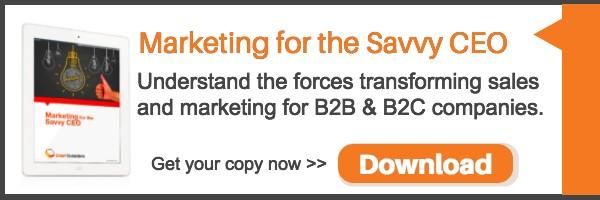CEO Blog - Advice for CEOs on growth and scaling
When is Return on Learning (ROL) More Important than ROI?


If you completed a class on finance and accounting, you are likely familiar with Return on Investment (ROI). Are you ready to take the pop quiz on how to calculate it? No? That’s OK, it’s not my objective here or to question your degree. What I do want to do is to highlight when to use ROI, and when an even more powerful concept, Return on Learning, or ROL, can be even more appropriate.
Here’s a situation. You are in a company that wants to make a significant investment in new digital go-to-market programs. Significant investments vary by the size of the proposed spend and the overall size of the company, but it’s quite unusual for the expected financial benefits to be measured. You want to be ahead of the financial folks, so you propose measuring ROI and payback. These are two popular and useful metrics. They aren’t universally used, though. I had a multi-billion per year client years ago and asked the financial folks what metrics we should use for a major investment. Their response: “No one has ever asked us for that before!” Investment metrics are often very unique to a management team and specific to a company.
All that said, while I’m a fan of ROI and payback, I’m often a bigger fan of ROL. Now you are scratching your head and trying to member the formula for ROL. Relax! There isn’t one. This isn’t a trick question. ROL is used especially when piloting or launching new offerings to the market.
ROL is how you might measure the amount of insight you have on customers, competitors, and markets. In their book The Growth Gears, Art Saxby and Pete Hayes lay out the argument for why your strategic planning needs to start with insight. Every client engagement I participate in starts out with me asking for every piece of insight the client has. Customer satisfaction scores, customer loyalty (Net Promoter Scores), brand audits, primary and secondary market studies, competitor profiles...everything they have collected. The amount of insight clients have provided me covers the spectrum from one (sort-of) research study, to reams and reams of data (which often have not been analyzed into implications and recommendations and so sit maturing in their native state).
If insight is critical to your planning, understanding what you are looking at and being willing and able to act on your learning are even more critical!
If you don’t have enough insight, then you’ll need to get more. Insight is power. Insight can be a competitive advantage. Insight can help you spot potential growth areas and act on them before your competitors do. Insight can be the difference between a new product or service launch that went OK, and one that exceeds your expectations for revenue growth.
Insight in the form of collected but unanalyzed data is where you start, but not where you finish. There is an information hierarchy that goes like this:
Facts → Findings → Implications → Recommendations → Actions
Having Facts (data) is good, translating them into Findings is better; taking them through further analysis into Implications and Recommendations will get you a gold star. Then actually doing something as a result of what you learned will get you the Good Housekeeping Seal of Approval (from me).
I’ve hinted at the benefits of insight, and how you can deploy insight through a Return on Learning (ROL) model. Here are a few other points you’ll need to know:
-Insight is never 100% right, nor 100% wrong. Be honest with yourself when a prospect or client shares a nugget with you, even if it’s not something you wanted to hear. Trust, but verify it by asking others.
-More insight is better than less insight. Too much insight can paralyze a business, but I’d bet that’s not a problem you have.
-To paraphrase words of George Orwell in his book “1984,” all insight is created equal, but some is more equal. Understand who provides you the best insight, then tap them regularly. They are often some of your more operationally excellent customers.
-To turn insight into Findings and Implications, you’ll need a good analyst who knows your business, your strategy, and your goals.
-To turn Implications and Recommendation and finally into Actions, your executive team needs to be deeply involved. And, you’ll need a Marketing Plan to make your opportunities real.
I call companies that are good at insight and learning “Outside In” companies, versus “Inside Out” companies that create offerings regardless of whether there is a market need and without an understanding of what value their products or services have for their customers.
Becoming a company whose culture is one of continuous learning can be a competitive advantage all by itself. I once encountered a new competitor in the direct marketing space who could generate four quarterly catalogs in the time it took us to do one. Their print quality wasn’t as good and they used a digest format instead of full-size paper, but they could test new products much more quickly, could adjust the placement of products in upcoming catalogs based on past sales performance, and as a result had much higher sales per page. Their cycle times were a fraction of ours—they were masters of ROL. We knew it was game over for us, and had to acquire them to remain competitive.
Your learning culture and operational practices may take some time to develop and mature, but why not get started now?
This article is part of a series where I share practical experience learned over 25 years as a Marketing executive. I’m happy to engage with you if you have another view, or want to expand on these ideas—especially if you have a need, or know a company that does.
Topics: ROI
Thu, Feb 16, 2017Related Articles

- Press Releases
- Careers
- Case Studies
- Marketing Consultant Company
- Marketing Strategy Consultants
- Marketing Plan Consultants
- B2B Marketing Consultants
- Virtual CMO
- Marketing Consultant Outsourcing
- Fractional CMO
- What is a Fractional CMO
- Healthcare Marketing Consultant
- Marketing Consultant Houston TX Texas
- Marketing Consultant Texas TX
- Marketing Consultant Bay Area
- CEO Blog
- Ebooks Plus
- Executive Marketing Consultants
- Product Marketing Consultants
- B2C Marketing Consultants
- Virtual Marketing Consultants
- Senior Marketing Consultants
- Temporary CMO
- Hire a CMO
- Fractional CMO Salary
- Fractional CMO Responsibilities
- Marketing Consultant Austin TX Texas
- Marketing Consultant Dallas TX Texas
- Marketing Consultant San Antonio
- Helping Private Equity
- Private Equity Blog
- Leadership Team
- Privacy Policy
- Business Marketing Consultants
- Strategic Marketing Consultants
- Marketing Technology Consultants
- Sales and Marketing Consultants
- CMO Job Description
- CMO Salary
- Fractional CMO Agency
- Fractional CMO Services
- CPG Marketing Consultant
- Marketing Consultant San Diego
- Partners
Houston, TX 77056
© 2023 Chief Outsiders


